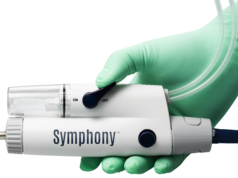A UK national initiative to carry out mandatory screening of hospital patients for deep vein thrombosis has resulted in a “significant” reduction in death rates, experts in Birmingham have concluded. A major study was carried out involving every single patient admitted to all 163 National Health Service (NHS) hospital trusts in England between July 2010 and March 2012.
The team from the Quality and Outcomes Research Unit (QUORU) of University Hospitals Birmingham NHS Foundation Trust, led by Domenico Pagano, sought to check the effectiveness of the venous thromboembolism risk screening programme introduced into all NHS hospitals.
They have now concluded that if all trusts achieved the required quality standard, they could expect that 280 deaths from venous thromboembolism would have been avoided among patients admitted to hospital for more than three days. In addition, a further 150 deaths within 90 days of discharge could have been prevented among patients with hospital admissions of less than four days.
The study, which is published in the journal Heart, followed on from the Department of Health in England’s decision in 2010 to introduce a quality incentive for NHS hospital trusts to screen at least 90% of admitted patients for the risk of developing venous thromboembolism. Those hospitals which assessed at least 90% of patient admissions achieved the quality standard.
The study concluded that there was a “statistically significant reduction” in venous thromboembolism deaths in hospitals achieving the risk assessment target, both for surgical and non-surgical patients.
The published report makes clear that hospital associated venous thromboembolism is a “potentially preventable” cause of death and disability, with the relative risk increasing more than 100 fold after hospital admissions for surgical procedures. But it added that deaths from venous thromboembolism are often sudden or are misdiagnosed pre-mortem and, therefore, prevention is a key strategy.
The analysis was based upon a series of monthly observations from each NHS Hospital Trust in England, and the association between outcomes and the achievement, or otherwise, of the venous thromboembolism risk assessment target in that month. The results showed that across the 21 months period of the study, on average, hospitals achieved the quality standard risk assessment 56% of the time.
But closer analysis revealed a substantial improvement over the time period, from 51% in the first month (July 2010) to 93% in the final month (March 2012).
The report concluded: “Achieving the venous thromboembolism risk assessment target was significantly associated with a reduction in death within 90 days of discharge both for primary venous thromboembolism deaths and for venous thromboembolism related deaths in patients with less than four days hospital stay. Our analyses provide convincing evidence of the effectiveness of the venous thromboembolism risk screening programme in the English NHS.
“Taking the year 2011 as the basis for this estimation, if all trusts achieved the quality standard, we could expect as a result that 280 deaths from venous thromboembolism (anywhere in the first three positions on the death certificate) would have been avoided among patients with admissions greater than three days.
“In addition we could expect that 150 deaths within 90 days of discharge would have been prevented among subjects with admissions less than four days. It is likely that this is an underestimate of the true number of venous thromboembolism fatalities.
“In summary, this study demonstrates that a national quality initiative to increase the number of patients screened for venous thromboembolism risk to at least 90%, linked to a financial penalty, has resulted in improvements in the outcome of death from venous thromboembolism up to 90 days after hospital admission.”
The complex statistical analysis in the study was conducted by a team led by Nick Freemantle from University College London, who is also the director of biostatistics at QUORU.












